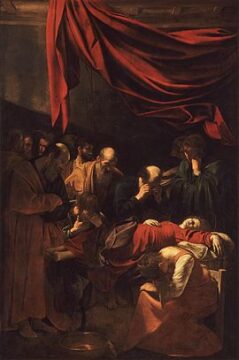Ed Simon at Hyperallergic:
 When the water-logged, bloated corpse of the drowned Maddalena Antognetti, a sex worker who used the name “Lena,” was dredged from Rome’s Tiber river in the summer of 1604, she was still beautiful. We know this because her sometimes-lover Michelangelo Merisi, who hustled under the name Caravaggio, used Lena’s dead body as a model in a masterpiece entitled “Death of the Virgin.”
When the water-logged, bloated corpse of the drowned Maddalena Antognetti, a sex worker who used the name “Lena,” was dredged from Rome’s Tiber river in the summer of 1604, she was still beautiful. We know this because her sometimes-lover Michelangelo Merisi, who hustled under the name Caravaggio, used Lena’s dead body as a model in a masterpiece entitled “Death of the Virgin.”
Completed around 1606 and now at the Louvre, the oil-on-canvas painting transubstantiates Lena into a red-tunicked Virgin Mary, sprawled in a cruciform position atop a gathering of sheets and pillows while an assemblage of apostles mourns around her. A composition such as “Death of the Virgin” is a representative example of Caravaggio’s brilliance when it came to the use of contrast, with the body of the dead Madonna bathed in an otherworldly light that seems to radiate from her being itself, while the periphery of the scene is a continuum of sonoluminescence veering from mild duskiness to the blackness of the void. Mary’s left hand rests on her sternum while the long, pale, and elegant fingers of her other reaches stiffly toward the viewer as rigor mortis sets in.
more here.
